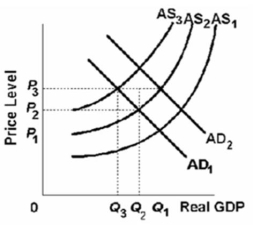Multiple Choice
 Refer to the above graph.Assume that the economy is at equilibrium at AD1 and AS1 and then is hit with both demand-pull and cost-push inflation.If this occurs, then, in the short run:
Refer to the above graph.Assume that the economy is at equilibrium at AD1 and AS1 and then is hit with both demand-pull and cost-push inflation.If this occurs, then, in the short run:
A) AD1 will shift to AD2, AS2 will shift to AS3, the price level will be at P2, and output will be at Q2.
B) AS1 will shift to AS3, AD2 will shift to AD1, the price level will be at P3, and output will be at Q3.
C) AD1 will shift to AD2, AS1 will shift to AS2, the price level will be at P2, and output will be at Q2.
D) AD1 will shift to AD2, AS1 will shift to AS2, the price level will be at P3, and output will be at Q1.
Correct Answer:

Verified
Correct Answer:
Verified
Q69: A criticism of the arguments for tax
Q71: <img src="https://d2lvgg3v3hfg70.cloudfront.net/TB6686/.jpg" alt=" Refer to the
Q72: <img src="https://d2lvgg3v3hfg70.cloudfront.net/TB6686/.jpg" alt=" Refer to the
Q74: Demand-pull inflation and cost-push inflation are identical
Q75: Which of the following most significantly contributed
Q76: In terms of aggregate supply, the short
Q77: <img src="https://d2lvgg3v3hfg70.cloudfront.net/TB6686/.jpg" alt=" Refer to the
Q78: <img src="https://d2lvgg3v3hfg70.cloudfront.net/TB6686/.jpg" alt=" Refer to the
Q101: The Phillips Curve suggests an inverse relationship
Q151: A basic criticism of supply-side economics is